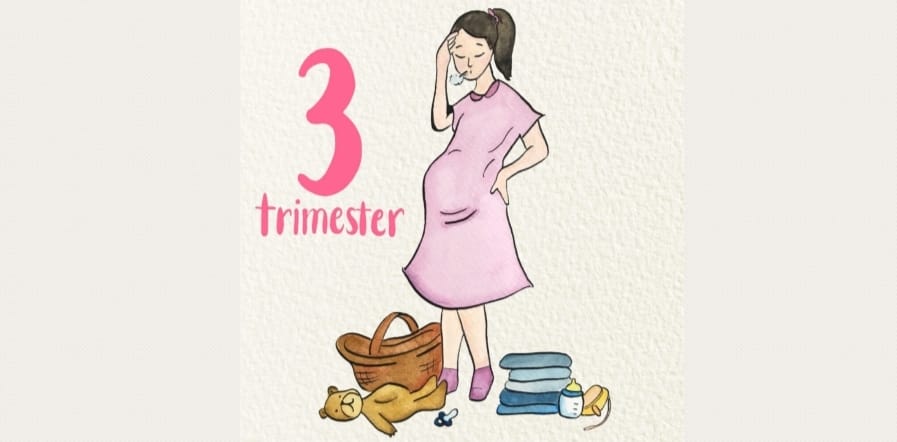THE THIRD TRIMESTER OF PREGNANCY

The third trimester is the last phase of your pregnancy. It lasts from weeks 29 to 40 or till the day baby arrives. Over the next few weeks, you will probably start to feel a bit more uncomfortable and tired. Your fetus continues to grow in size and weight. The lungs are still maturing, and the fetus begins to position itself head down. By the end of the third trimester, the fetus is about 19 to 21 inches long and weighs, on average, 6 to 9 pounds.
Significance of Third Trimester-
The third trimester marks the home stretch, as you prepare for the delivery of your baby. The fetus is continuing to grow in weight and size, and the body systems finish maturing. You will continue to gain weight and begin to have false labor contractions (Braxton-Hicks contractions).
Fetal development during the Third Trimester includes the following-
- The fetus can see and hear.
- The fetus can suck its thumb.
- The fetus can cry and smile.
- By the 36th week, the head may “engage” (drop into the pelvic area). This is a process called “lightening.”
- The brain continues to develop.
- The kidneys and lungs continue to mature.
- The bones of the skull stay soft to make it easier to pass through the birth canal.
- For many babies, the irises of the eyes are slate blue. The permanent eye color will not appear until several days or weeks after birth.
- By 38 to 40 weeks, the fetus’ lanugo has almost all gone away.
- By 38 to 40 weeks, the lungs have matured fully.
- The baby is covered in vernix caseosa (or simply called vernix). This is a creamy, protective coating on the skin.
Danger signs of Third Trimester-
- Abdominal pain, continuous or severe.
- Regular contractions or tightening of the uterus before 36 weeks .(greater than four contractions in one hour)
- Chills and fever over 100.4 degrees Fahrenheit.
- Vaginal heavy bleeding.
- Sudden or extreme swelling.
- Headaches with spots or flashing lights that do not go away.
- Sudden increase in vaginal discharge
Talk with your Health care provider if you have any of the signs of labor: Regular tightening or pain in your lower abdomen or back that occurs more than four times in an hour, any bleeding in your third trimester of pregnancy or any fluid leakage.
Take care of your self-
What to do:
- Continue to take prenatal vitamins.
- Stay active unless you’re experiencing swelling or pain.
- Work out your pelvic floor by doing Kegel exercises.
- Eat a diet high in fruits, vegetables, low-fat forms of protein, and fiber.
- Drink lots of water.
- Eat enough calories (about 300 more calories than normal per day).
- Stay active with walking.
- Keep your teeth and gums healthy. Poor dental hygiene is linked to premature labor.
- Get plenty of rest and sleep.
What to avoid:
- strenuous exercise or strength training that could cause an injury to your stomach
- alcohol
- caffeine (no more than one cup of coffee or tea per day)
- smoking
- raw sprouts
- long car trips and airplane flights
- If you must travel, stretch your legs and walk around at least every hour or two.
Exercise during Second Trimester-
In the third trimester (weeks 28 to 40) you can carry on exercising as long as you feel well and comfortable. If you feel okay, you can stay active right up to the birth of your baby.
5 exercises to train for labor and delivery:
- Child’s pose- This yoga pose helps lengthen pelvic floor muscles and ease discomfort.
- Deep squat- Deep squats help relax and lengthen the pelvic floor muscles and stretch the perineum.
- Quadruped cat/cow- This yoga pose helps ease discomfort and decrease lower back pain.
- Perineal bulges- This trains you to push during delivery without holding your breath.
- Perineal massage- Perineal massage lengthens and softens the tissues of the perineum.
Signs of labor-
- Learning the signs of labor before your due date can help you feel ready for your baby’s birth.
- Signs of labor include strong and regular contractions, pain in your belly and lower back, a bloody mucus discharge and your water breaking.
- If you think you’re in labor, call your health care provider.
